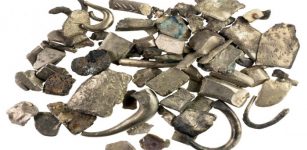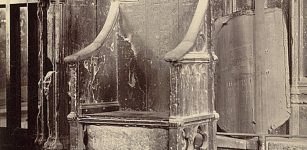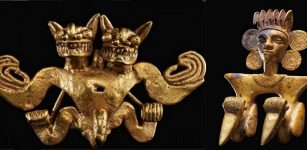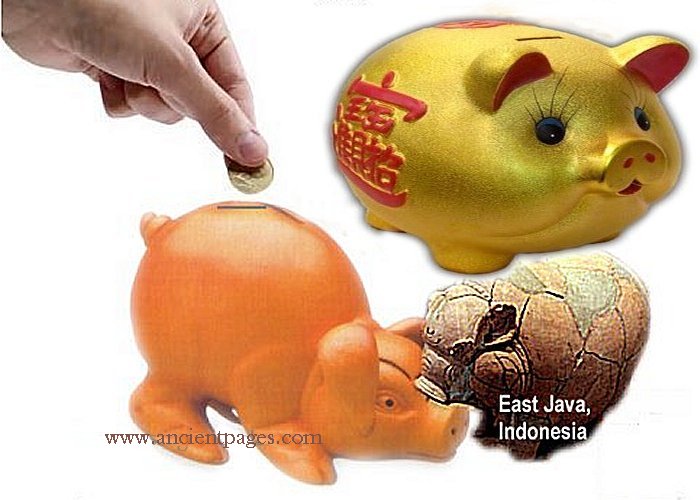Why Is A ‘Piggy Bank’ Shaped Like A Pig?
AncientPages.com - In early European times, most household wares like dishware, jars and barrels were made of dense, orange-colored, economical clay.
People used to put their small savings in kitchen jars made of this clay and called them "piggy jars".
Later, the jars became known as " piggy bank" or " piggy banks" because like all banks, they stored coins inside them.
The etymology of the expression "piggy bank" is rather concealed in obscurity but the most popular story is that during the 1800's, an English jar maker made a mistake.
When some customers ordered " piggy banks", he produced banks but shaped like a pig.
Although the customers did not get what they expected, they liked the final product very much. Funny pigs delighted children and the customers were really fond of them!
Soon, all potters and jar makers were overwhelmed by new orders to produce toy-like figurines representing a pig, which had no hole in the bottom, so the pig had to be broken to get the money out.
To this day, in some countries, it is customary to give "piggy banks" as gifts because they are, in fact, great gift ideas for home and office as well.
In these countries, among many deeply held beliefs, there is one saying that pigs bring luck and good fortune.
The "piggy bank" is an ancient phenomenon.
As we know, money, is an important part of human life and apparently to save money is considered to be a deeply rooted custom of humans nature.
A "piggy bank" dated to about 330-280 BC during the excavations on the site of ancient Babylon, not far from Iraq's capital of Baghdad.
Another money box dated back to 2nd century BC, the so-called Priene "piggy bank" of baked clay, was found in ancient ruins of Priene, near Efeso, located south off an ancient Greek seaport of Asia Minor.
See also:
Our Lives Have Always Been Manipulated By Money – Part 1-3
Modern Banking Concept Started In Ancient Babylonian Temples
A great variety of prehistoric money boxes were also excavated in Pompeii and Herculaneum, Italy and a terracotta "piggy bank" shaped like a pig and dated back 1,500 years was unearthed in East Java, Indonesia.
Since ancient times, people have been saving money in pig-shaped containers.
Copyright © AncientPages.com All rights reserved. This material may not be published, broadcast, rewritten or redistributed in whole or part without the express written permission of AncientPages.com
More From Ancient Pages
-
 7,000-Year-Old Unique Artifacts Discovered Under Melting Ice In Canada
Archaeology | Nov 30, 2023
7,000-Year-Old Unique Artifacts Discovered Under Melting Ice In Canada
Archaeology | Nov 30, 2023 -
 Shinobi No Mono: The Shadow Warriors And Hattori ‘The Demon’ Hanzo Of Ancient Japan
Featured Stories | Apr 8, 2016
Shinobi No Mono: The Shadow Warriors And Hattori ‘The Demon’ Hanzo Of Ancient Japan
Featured Stories | Apr 8, 2016 -
 What Are The Most Common Misconceptions About Pirates?
Ancient History Facts | Apr 16, 2024
What Are The Most Common Misconceptions About Pirates?
Ancient History Facts | Apr 16, 2024 -
 Hacksilber Hoard Dated To 11th Century BC: Eastern Mediterranean Silver Trade Reconstructed
Archaeology | Jul 5, 2021
Hacksilber Hoard Dated To 11th Century BC: Eastern Mediterranean Silver Trade Reconstructed
Archaeology | Jul 5, 2021 -
 Early Neolithic High Mountain Settlers Were Busy With Complex Livestock And Farming Activities – New Study
Archaeology | Dec 22, 2023
Early Neolithic High Mountain Settlers Were Busy With Complex Livestock And Farming Activities – New Study
Archaeology | Dec 22, 2023 -
 Stone of Scone: Mysterious Stone Of Destiny Has Turbulent Ancient History
Artifacts | Mar 19, 2016
Stone of Scone: Mysterious Stone Of Destiny Has Turbulent Ancient History
Artifacts | Mar 19, 2016 -
 DNA Offers Insights Into The Use Of Plants By Humans In The Paleolithic Age
Archaeology | Oct 13, 2022
DNA Offers Insights Into The Use Of Plants By Humans In The Paleolithic Age
Archaeology | Oct 13, 2022 -
 World’s Oldest Dictionaries Are 4,500-Year-Old Cuneiform Tablets Discovered In Ebla
Ancient History Facts | Aug 19, 2016
World’s Oldest Dictionaries Are 4,500-Year-Old Cuneiform Tablets Discovered In Ebla
Ancient History Facts | Aug 19, 2016 -
 Thousands Magnificent Jade Artifacts Discovered In Han Dynasty Tombs – China’s Golden Age In New Light
Archaeology | Jul 23, 2020
Thousands Magnificent Jade Artifacts Discovered In Han Dynasty Tombs – China’s Golden Age In New Light
Archaeology | Jul 23, 2020 -
 Discovered – Large Mysterious Structure Hidden Under The Sand In The Sahara Desert – A New Pyramid Or Something Else?
Archaeology | Nov 13, 2019
Discovered – Large Mysterious Structure Hidden Under The Sand In The Sahara Desert – A New Pyramid Or Something Else?
Archaeology | Nov 13, 2019 -
 Strange Engraving Made By Knights Templar In French Village – It Doesn’t Make Sense Or Does It? – Part 2
Featured Stories | Oct 9, 2019
Strange Engraving Made By Knights Templar In French Village – It Doesn’t Make Sense Or Does It? – Part 2
Featured Stories | Oct 9, 2019 -
 Gil Pérez: Unexplained Ancient Teleportation Of A Spanish Soldier
Featured Stories | Oct 15, 2018
Gil Pérez: Unexplained Ancient Teleportation Of A Spanish Soldier
Featured Stories | Oct 15, 2018 -
 The Magnificent Yule Goat In Gävle, Sweden Has Finally Arrived
Ancient Traditions And Customs | Dec 1, 2020
The Magnificent Yule Goat In Gävle, Sweden Has Finally Arrived
Ancient Traditions And Customs | Dec 1, 2020 -
 Legendary Pirate Black Sam And His Ship Discovered Off The Coast Of Cape Cod
Archaeology | Feb 12, 2018
Legendary Pirate Black Sam And His Ship Discovered Off The Coast Of Cape Cod
Archaeology | Feb 12, 2018 -
 Coronavirus: Advice From The Middle Ages For How To Cope With Self-Isolation
Featured Stories | Mar 29, 2020
Coronavirus: Advice From The Middle Ages For How To Cope With Self-Isolation
Featured Stories | Mar 29, 2020 -
 On This Day In History: James Cook – Navigator And Explorer – Killed On Feb 14, 1779
News | Feb 14, 2017
On This Day In History: James Cook – Navigator And Explorer – Killed On Feb 14, 1779
News | Feb 14, 2017 -
 Mysterious Sophisticated Gran Coclé Culture Reveals Its Ancient Secrets
Civilizations | Mar 9, 2020
Mysterious Sophisticated Gran Coclé Culture Reveals Its Ancient Secrets
Civilizations | Mar 9, 2020 -
 Climate In The Andes Has Driven 7,000 Years Of Dietary Changes – New Study Reveals
Archaeology | Feb 9, 2022
Climate In The Andes Has Driven 7,000 Years Of Dietary Changes – New Study Reveals
Archaeology | Feb 9, 2022 -
 Beautiful Legend Of La Befana – Witch Who Delivers Gifts To Children In Italy On Epiphany – Twelve Days After Christmas
Ancient Traditions And Customs | Dec 3, 2017
Beautiful Legend Of La Befana – Witch Who Delivers Gifts To Children In Italy On Epiphany – Twelve Days After Christmas
Ancient Traditions And Customs | Dec 3, 2017 -
 Clan MacGregor: Fearless, Lawless And Persecuted Clan Of The Highlands
Featured Stories | Jul 9, 2018
Clan MacGregor: Fearless, Lawless And Persecuted Clan Of The Highlands
Featured Stories | Jul 9, 2018


